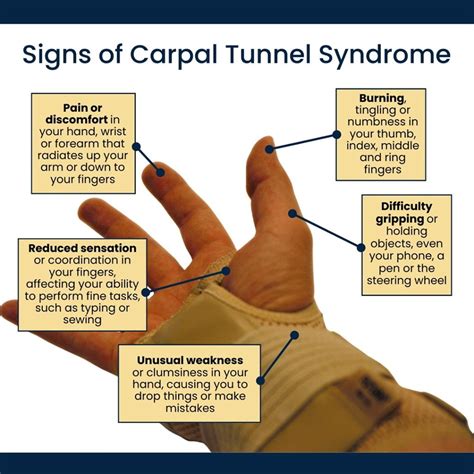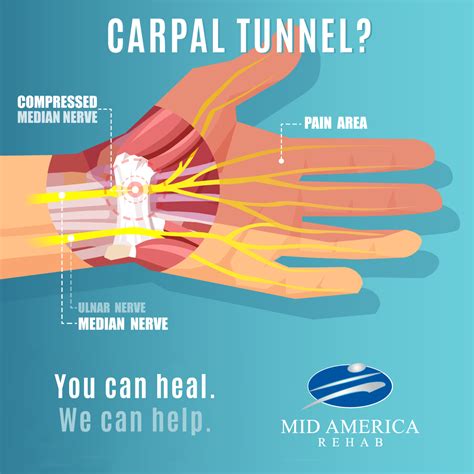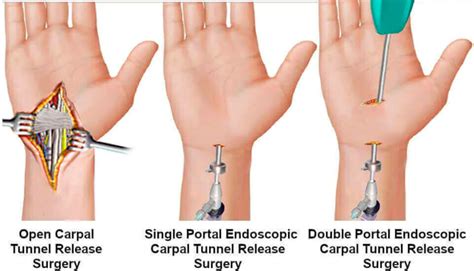Intro
Relieve carpal tunnel syndrome with 5 effective ways, including ergonomic adjustments, wrist exercises, and pain management techniques to reduce numbness, tingling, and hand strain, promoting overall hand health and wellness.
Carpal tunnel syndrome is a common condition that affects millions of people worldwide, causing numbness, tingling, and pain in the hands and wrists. The carpal tunnel is a narrow passageway in the wrist that protects the median nerve, which controls sensation and movement in the thumb and fingers. When the median nerve is compressed or pinched, it can cause a range of symptoms, from mild discomfort to debilitating pain. Understanding the causes and symptoms of carpal tunnel syndrome is essential to finding effective treatments and preventing long-term damage. In this article, we will explore the importance of treating carpal tunnel syndrome and discuss the various ways to alleviate its symptoms.
The importance of treating carpal tunnel syndrome cannot be overstated. If left untreated, the condition can lead to permanent nerve damage, causing chronic pain, numbness, and weakness in the hands and wrists. This can significantly impact daily activities, making it difficult to perform even simple tasks, such as typing, cooking, or driving. Moreover, carpal tunnel syndrome can also affect mental health, leading to anxiety, depression, and stress. Therefore, it is essential to seek medical attention if symptoms persist or worsen over time. Fortunately, there are various treatment options available, ranging from non-invasive techniques to surgical interventions.
Carpal tunnel syndrome can be caused by a combination of factors, including repetitive motion, poor posture, and underlying medical conditions, such as diabetes or arthritis. Understanding the underlying causes of the condition is crucial to developing an effective treatment plan. In some cases, making simple lifestyle changes, such as taking regular breaks, stretching, and improving posture, can help alleviate symptoms. However, in more severe cases, medical intervention may be necessary to prevent long-term damage. In the following sections, we will discuss the various ways to treat carpal tunnel syndrome, including non-invasive techniques, physical therapy, and surgical interventions.
Understanding Carpal Tunnel Syndrome

Symptoms of Carpal Tunnel Syndrome
The symptoms of carpal tunnel syndrome can vary from person to person, but common symptoms include numbness, tingling, and pain in the hands and wrists. In some cases, the symptoms can be mild, causing minor discomfort, while in other cases, the symptoms can be severe, causing debilitating pain and numbness. The symptoms can also be intermittent, occurring only at certain times of the day or during specific activities. Understanding the symptoms of carpal tunnel syndrome is essential to seeking medical attention and developing an effective treatment plan.Treatments for Carpal Tunnel Syndrome

- Physical therapy: Physical therapy can help alleviate symptoms by improving range of motion, reducing pain, and strengthening the muscles in the hands and wrists.
- Medications: Medications, such as pain relievers and corticosteroids, can help reduce pain and inflammation.
- Alternative therapies: Alternative therapies, such as acupuncture and massage, can help reduce pain and improve range of motion.
- Surgical interventions: In severe cases, surgical interventions may be necessary to release the compressed median nerve.
Non-Invasive Techniques
Non-invasive techniques can be an effective way to alleviate symptoms of carpal tunnel syndrome. These techniques can include physical therapy, medications, and alternative therapies. Physical therapy can help improve range of motion, reduce pain, and strengthen the muscles in the hands and wrists. Medications, such as pain relievers and corticosteroids, can help reduce pain and inflammation. Alternative therapies, such as acupuncture and massage, can help reduce pain and improve range of motion.Physical Therapy for Carpal Tunnel Syndrome

Exercises for Carpal Tunnel Syndrome
Exercises can be an effective way to alleviate symptoms of carpal tunnel syndrome. The following are some exercises that can help improve range of motion, reduce pain, and strengthen the muscles in the hands and wrists:- Wrist extensions: Hold your arm straight out in front of you and lift your hand up, using your wrist to lift your hand.
- Wrist flexions: Hold your arm straight out in front of you and lower your hand down, using your wrist to lower your hand.
- Finger bends: Hold your arm straight out in front of you and bend your fingers down toward your palm.
- Finger spreads: Hold your arm straight out in front of you and spread your fingers apart as far as you can.
Surgical Interventions for Carpal Tunnel Syndrome

Risks and Complications of Surgical Interventions
As with any surgical procedure, there are risks and complications associated with surgical interventions for carpal tunnel syndrome. The following are some of the potential risks and complications:- Infection: As with any surgical procedure, there is a risk of infection with surgical interventions for carpal tunnel syndrome.
- Nerve damage: There is a risk of nerve damage with surgical interventions for carpal tunnel syndrome, which can cause numbness, tingling, and pain.
- Scarring: Surgical interventions for carpal tunnel syndrome can cause scarring, which can be permanent.
- Recurrence: There is a risk of recurrence with surgical interventions for carpal tunnel syndrome, which can cause symptoms to return.
Preventing Carpal Tunnel Syndrome

- Take regular breaks: Taking regular breaks can help reduce the risk of developing carpal tunnel syndrome.
- Stretch: Stretching can help improve range of motion, reduce pain, and strengthen the muscles in the hands and wrists.
- Improve posture: Improving posture can help reduce the risk of developing carpal tunnel syndrome.
- Use proper equipment: Using proper equipment, such as ergonomic keyboards and mice, can help reduce the risk of developing carpal tunnel syndrome.
Lifestyle Changes for Preventing Carpal Tunnel Syndrome
Making lifestyle changes can be an effective way to prevent carpal tunnel syndrome. The following are some lifestyle changes that can help reduce the risk of developing the condition:- Take regular breaks: Taking regular breaks can help reduce the risk of developing carpal tunnel syndrome.
- Stretch: Stretching can help improve range of motion, reduce pain, and strengthen the muscles in the hands and wrists.
- Improve posture: Improving posture can help reduce the risk of developing carpal tunnel syndrome.
- Use proper equipment: Using proper equipment, such as ergonomic keyboards and mice, can help reduce the risk of developing carpal tunnel syndrome.
Conclusion and Final Thoughts

We hope this article has provided you with valuable information about carpal tunnel syndrome and its treatment options. If you have any questions or comments, please feel free to share them with us. We would be happy to hear from you and provide any additional information or support you may need. Additionally, if you found this article helpful, please consider sharing it with others who may be experiencing similar symptoms or conditions.
What are the symptoms of carpal tunnel syndrome?
+The symptoms of carpal tunnel syndrome can include numbness, tingling, and pain in the hands and wrists. In some cases, the symptoms can be mild, causing minor discomfort, while in other cases, the symptoms can be severe, causing debilitating pain and numbness.
What are the treatment options for carpal tunnel syndrome?
+The treatment options for carpal tunnel syndrome can include non-invasive techniques, such as physical therapy and medications, as well as surgical interventions. The treatment approach will depend on the severity of the condition, as well as the underlying causes.
How can I prevent carpal tunnel syndrome?
+Preventing carpal tunnel syndrome is essential to reducing the risk of developing the condition. The following are some ways to prevent carpal tunnel syndrome: take regular breaks, stretch, improve posture, and use proper equipment, such as ergonomic keyboards and mice.
What are the risks and complications of surgical interventions for carpal tunnel syndrome?
+As with any surgical procedure, there are risks and complications associated with surgical interventions for carpal tunnel syndrome. The following are some of the potential risks and complications: infection, nerve damage, scarring, and recurrence.
What are the benefits of physical therapy for carpal tunnel syndrome?
+Physical therapy can be an effective way to alleviate symptoms of carpal tunnel syndrome. A physical therapist can work with you to develop a personalized treatment plan that includes exercises, stretches, and other techniques to improve range of motion, reduce pain, and strengthen the muscles in the hands and wrists.
